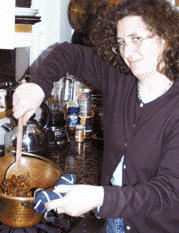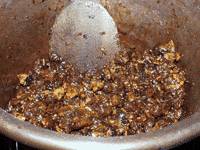
May 1998
Paola's Paiolo
Topsham, Devon 9 May 1998 Our friend Paola has a paiolo, an odd-shaped copper cooking pot with a wide, flared mouth and a hooped handle which you hang from a hook over an open fire. It is not overly large, perhaps some 20 cm in diameter at the mouth, less at the base, sufficient to hold about 5 litres. It is old and heavy and clearly well-used and much-loved. "My father gave it to me," she explained when she first brought it over to our house last year, "when I came from Italy to live in England so that I could make polenta in the real way." That is to say, in the classic manner, utilising the finest stoneground polenta cornmeal (which she brings back from her hometown of Varese) and cooked in the paiolo together with only water and a pinch of salt. To stir the polenta, something of an arm-aching -- and sometimes dangerous -- ritual in itself (polenta has the propensity to spit), Paola uses a bastoncino, a wooden stirring stick handcarved by her father himself. Paola's polenta is probably the best we've ever eaten.
Paola cycled over to visit us this weekend, and she brought her paiolo with her in a knapsack, together with some almonds, sugar and a few lemons. "We'll make torrone croccante," she told Guy and Bella, "You can help me." Thus after dinner, enjoyed for the first time this year outside in the garden, watching the Mirror sailing dinghies returning upriver from the Exe Challenge series of races as the sun went down over the Exminster marshes, Paola set them to work: Bella grating the lemon rind, Guy measuring the almonds and sugar, and then the two of them taking turns helping Paola to stir the mixture. The recipe is exceedingly simple: no more than coarsely chopped almonds, an equal quantity of white sugar (we used 400 g. of each), the rind of two lemons plus a pinch of cinammon. The method: add the chopped almonds and the sugar to a paiolo di rame (copper pot) or other heavy-based saucepan, and place over a medium-low flame, stirring all the while. The mixture appears very dry, and you need to be patient and keep stirring to ensure that it does not burn on the bottom of the pan. After 20-25 minutes, a magical transformation suddenly occurs: the sugar, ever so slowly at first, then all of a sudden, melts to liquid, there is a glorious aroma of toasted almonds and burnt sugar, and the caramel syrup transforms to a deep chestnut brown colour. "Ahh," said Paola, "the smell of Christmas!", the traditional time of the year to make this favourite Italian candy.
Once the mixture has become a homogeneous, dark brown mix, it is simply turned out onto a well-oiled board or, better still, a cool marble slab. Using an oiled or wet rolling pan, the mixture is flattened, and it quickly begins to set as hard as glass. The temptation is overwhelming to pop a bit of the crunchy, fragrant candy in your mouth, but it is still deceptively hot, as little Bella found out to her cost. Before the croccantegoes completely hard, it is cut into strips, then into little squares. Once cool, we enjoyed it immediately. (It will apparently keep well for some time, but unfortunately, we cannot confirm this as we scoffed the lot with embarrassing rapidity).
As Paola left that evening, copper pot in her zaino strapped to her back, she patted the knapsack with quiet satisfaction and said, "It's good to get the paiolo out and use it from time to time."
copyright © Marc & Kim Millon 2000
![]()
|Home| |QP New Media| |Kim's Gallery|
![]()
Copyright © Marc and Kim Millon 2000


